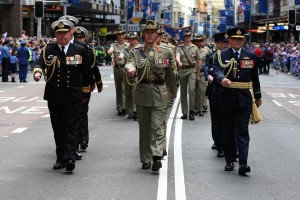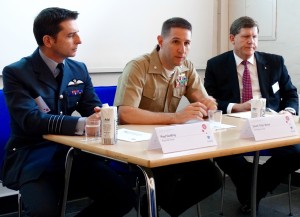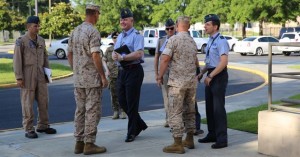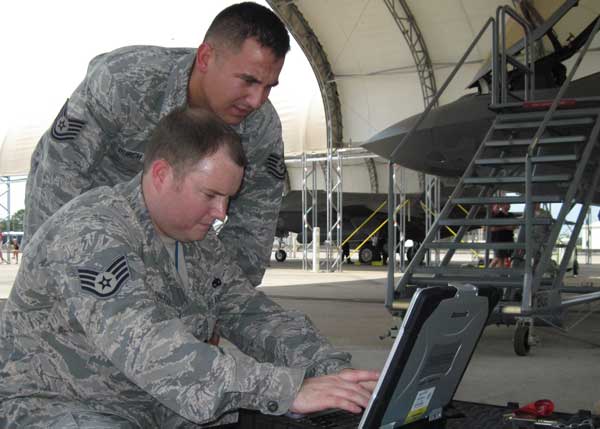2015-10-18 By Robbin Laird
The Royal Australian Air Force is shaping a transformation strategy, which they call Plan Jericho.
In anticipation of the coming of the F-35, the RAAF is looking to shape a 21st century joint force built around the F-35.
The Plan Jericho approach is about shaping a more integrated force built on 21st century situational awareness and decision-making systems.
It is a work in progress for the Royal Australian Air Force and the Australian Defence Force.
It is clearly not just about platforms, but how you re-shape the concepts of operations, and transform to a more integrated force.
Clearly required is also a transformation of training and logistics, key elements of what professionals pay attention to but do not get the focus of attention which platform acquisition itself receives.

In an interview with the Air Commander of Australia, Air Vice Marshal Turnbull., highlighted their importance:
Question: You are clearly shaping a 21st century expeditionary force, how do you deal with the challenge of shaping a logistics system, which can enable it?
Air Vice Marshal Turnbull: Logistics is not an exciting subject but it is essential to any operational success.
We must make sure that it’s not so much a specific force, but it’s our ability to project a force within an appropriate timeframe wherever we may want it effectively.
As we develop capability we have to maintain a keen eye on the fact it needs to be designed to be moved quickly and efficiently from wherever we garrison to wherever we operate.
A deployable mindset is the key to keep people innovating in the right way.
For our logistics to be able to service our requirements anywhere in the world in a reasonable timeframe is a key focus for our transformation efforts.
Leveraging the F-35 global enterprise is seen as a key element of the effort, and with it shaping a sustainment approach, which can fully work with that enterprise.
In an interview with Air Vice Marshal (retired) John Blackburn, who has been associated with the effort from its beginning last year, the sustainment aspect of the effort was highlighted.
What we’ve seen in the past is that the logistics part has been underemphasized. We’ve always emphasized the platform and the logistics element is the poor cousin that follows in its trail.
For example, how are we going to provide situational awareness, common information systems across the whole logistics base. What we’re seeing now with global supply chains, and using the JSF as an example, is you’re actually looking at supporting your platform with a global supply chain, which is actually shared with all the other partner nations.
There are two key issues, which need to be addressed.
First, one needs to optimize delivery through a global supply chain vertically, if you want to put it that way. And then for the national force, you’re going to look horizontally across each of those supply chains, and so how does the joint logistics area manage that?
Do you order supplies only through that vertical global supply chain or do you rationalize across your force and your force holdings by the national joint supply chain?
We have to understand that you are going to end up optimizing platforms to the global supply chain such as the JSF for very good reasons. How that integrates and interfaces in a country-by-country case into a cross capability logistics system, I don’t think is understood as yet.
This is a critical issue to understand so that we can deploy as effectively as possible, and operate across a range of capabilities in a more complex logistics environment in the future.
Addressing both the national and global F-35 approaches are important because they are at the cutting edge of an approach which may well be repeated with regard to other systems to be supported globally in the future by US and allied militaries.
In other words, the F-35 system is a pathfinder effort for squaring the circle between a global supply chain and supply chains for a transformed joint force towards which Australia is clearly working.
Question: To put it into your words, the challenge is squaring the dynamics of a global vertical supply chain with a nationally based ability to supply your force?
Air Vice Marshal (Retired) Blackburn: The challenge you face now is a far more complicated logistics information system that needs to not only work in that vertical axis but in the horizontal axis country-by-country, and then you have to make some hard decisions because you’re not a just-in-time civil supply system. You need a resilient supply base, and not just depend on just-in-time deliveries from a global supply chain.
Cost is a critical factor as well.
If I quote from the Australian Strategic Policy Institute defense budget report of this year, they are projecting a 5.2 percent real growth per annum – real growth – in sustainment costs. When you look at the scale of that operating cost for a force like ours, that’s something that’s got to have to be managed very carefully to make sure that our force remains affordable.
I think the sustainable logistics part is going to be a very, very important factor in supporting a transformation effort.

Question: What are your thoughts on the cross-cutting of the training and logistics challenges for transformation?
Air Vice Marshal (Retired) Blackburn: They are cross-cutting. It is important in the training of pilots to operate for the joint force to understand that an airplane without sustaining capability is a museum piece. It’s nice to look at but not much use.
We have to educate our people from day one. There’s a bigger world out there, and yes in the first part of your career, you focus on your specific skillsets, in being a pilot, an air combat officer, or logistician, or an air traffic controller or a battle manager for example. But, if you don’t understand how it works as a system, then you’re not going to be much use as you progress in your career.
I would argue that day one in any of our military courses, you start to get the students to understand they’re part of a larger system. The critical learning point is that it is not just the platform; it’s the total system that matters.
A similar perspective is emerging for the Royal Air Force as well.
In an interview with Group Captain Ian Townsend, a key officer involved in working the F-35 introduction into service for the RAF, the importance of the global enterprise was highlighted as well.
Question: You are working the task of bringing the F-35B to the UK in 2018 and preparing for its integration with the Queen Elizabeth.
What role does your engagement with the Marines at Beaufort play in this process?
Group Captain Townsend: We have a pooling implementation agreement or PIA with the Marines.
The PIA formalizes how we’re going to work alongside them. We currently have 14 maintainers at MCAS Beaufort but, by the end of 2018, we’ll have about 242 maintainers.
They are all operating under the U.S. Marine Corps regulations and will be ready to come back to the U.K. and operate F-35 independently in late 2018.
Question: And concurrently, you are building your own infrastructure in the UK to then support your F-35s in the UK?
Group Captain Townsend: That is correct. It is a massive effort to put in place the UK infrastructure but we are learning significant lessons from other F35 partner nations.
We are conducting developmental test flying, operational test flying and frontline flying all at the same time, something we call concurrency. We’ve never done that before. If we hadn’t taken that approach, none of the F-35 operators would be where we are right now.
The Marine Corps wouldn’t be IOC, if they haven’t taken that approach.
And we certainly wouldn’t be thinking about IOC in 2018 if we hadn’t taken that concurrency approach.
Working alongside the Marines not only allows exposure to F35 operations through the maintenance department, but our pilots are also working alongside their Marines equivalents. We’re training to the 501 Operational Conversion Syllabus, so we will now know exactly what the Marines are trained to go and do, which I think will make us better partners in the future as well.
Question: And by then, the Queen Elizabeth will be doing sea trials and getting ready to accept you?
Group Captain Townsend: That is the target. The first period of developmental testing onboard the Queen Elizabeth happens at the end of 2018. We have a second period in the mid-part of 2019, and then we will conduct continuation training on the ship before she achieves operational capability at the end of 2020.
Question: One misunderstanding often is that the Royal Navy is seen to be flying the F-35B where it is really the RAF. And the RAF is flying both the upgraded Typhoon and F-35B and working through their integration.
How would you describe the importance of the RAF working both processes concurrently?
Group Captain Townsend: I think this plays very nicely into the fact that the Royal Air Force is the air-minded service. We focus solely on being the expert deliverers of air power.
However, being a joint force, we have the additional benefit of having Fleet Air Arm pilots embedded within the U.K. Lightning Force. So there is no Royal Air Force Lightning Force.
There is no Royal Navy Lightning Force.
We are just one force.
And we’re bringing together the expertise of both elements of light blue and dark blue uniforms to provide the very best effect for carrier strike in the future.
Question: It was clear looking at reactions to the USS Wasp sea trials, that the core point of the integration of the ship with the airplane was largely missed. The Queen Elizabeth is a ship designed for the F-35B and the F-35B will provide unique capabilities which the ship can capitalize on in shaping its concept of operations.
How would you describe this synergistic process?
Group Captain Townsend: As an airman, I like anything that enhances my ability to deliver air power, and the ship certainly does that. The ship has been tailor-made from first principles to deliver F-35 operational output. The ship is part of the F35 air system.
I think this is the key change to where we were in Joint Force Harrier where the ship was really just a delivery vehicle. The ship was just a runway.
The Queen Elizabeth class aircraft carriers are much more than that. They are right at the heart of the air system’s capability fundamentally enabling and supporting what the air vehicle is doing three, or four, or five hundred miles away from the ship. And that wasn’t quite the same in Joint Force Harrier with the invincible class CVS carriers.
So it’s very different for us.
Everyone involved in embarked F-35 operations needs to understand what the air vehicle is going off to do because everybody on the ship is much closer to that end delivery of effect.This is a very different concept of operations from 15 years ago.
When I launched from the CVS in 2005 to fly an operational misison in Afghanistan, once I left the deck, I was gone.
The next contact I would have with the ship was when I called for recovery, several hours later.

Whilst I was airborne the ship and I became very separate operational platforms. When a UK Lightning launches from the QUEEN ELIZABETH, the information link between the air vehicle and the ship now means that they remain connected during the operation greatly enhancing operational capability.
In terms of being an information node or a C2 node, we’re in a much different place now.
And I think that’s really quite interesting for us as air commanders in terms of our ability to control what is going on forward with the airplanes.
I also think from a pilot’s perspective, being on the deck in my F-35, being able to see in my cockpit what is going on in the battle space, because my brothers in their F-35s already in the operational battlespace have sent information back to me, I think that’s really exciting as well.
We are no longer launching into the unknown.
We can see what’s happening.
We understand what we’re going off to go and do, but we can see the real-time situation in the battle space before we launch off the deck. A significant operational benefit..
Question: The impact of the global fleet of F-35s is significant as well in shaping enhanced capability for the Queen Elizabeth-F-35 enabled air system as well.
How do you see the impact of the F-35 global enterprise on the RAF?
Group Captain Townsend: There are many benefits. Not just in terms of training alongside each other and seeing the TTP developments, but practically when you’re in the battle space, how much information can you get from all of these different F-35 partners that are out there.
Broadening that question a little bit further, being part of the global platform and global sustainment, what are the opportunities there about not having to take all logistics with you?
What can you do to leverage off an Italian ship that’s nearby that might have the particular part that you need but you might not have it because you haven’t had to take anything forwards.
There’s an awful lot of questions being raised and a lot of opportunities available about being part of this global platform.
Again, this is something that we in the U.K. have never done before and there are a number of lessons ahead.
Question: I believe that any new platform needs a decade to put its legs under it. But the basic point is that we’re moving in a different direction from the beginning, rather than spinning our wheels with historic patterns.
And your perspective is the need to get on with it, more or less?
Group Captain Townsend: I think that’s absolutely right and inevitable. But at least, the foundation has been set. The partners involved in the global platform understand each other’s business, from the outset, in a way that we haven’t really seen ever before.
I think the closest equivalent you could come to would be the F-16 program that was widely sold across the world, but every nation did F-16 differently.
There were different support solutions for every F-16 operating nation.
By and large, anyone operating F-35 is going to be doing it in broadly the same way with the same sort of broad sustainment solution.
That’s part of the global program.
That’s what makes it an attractive option for everyone that’s involved.


